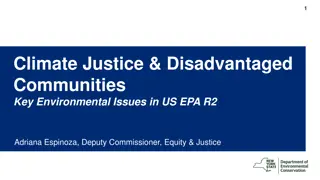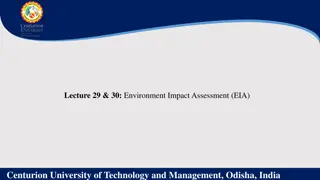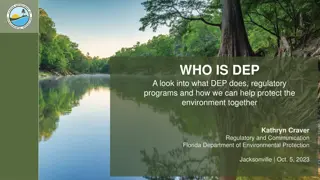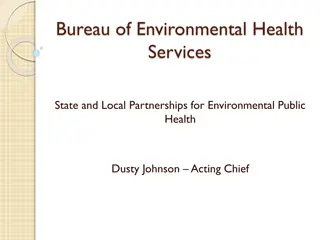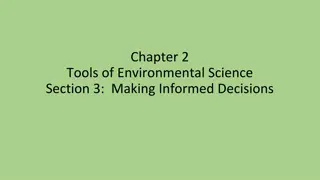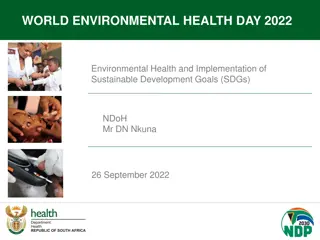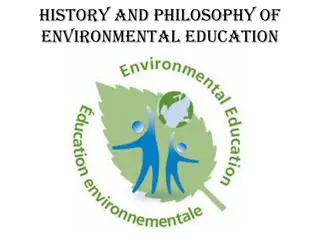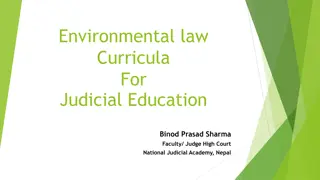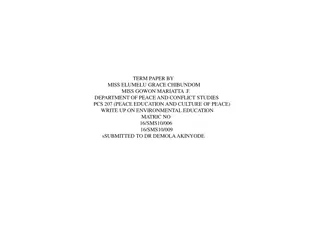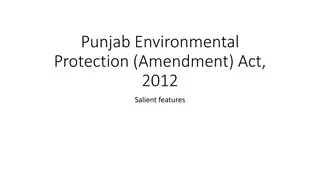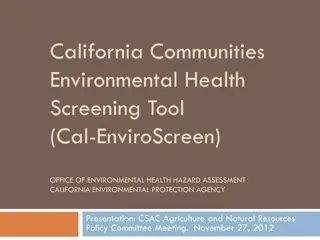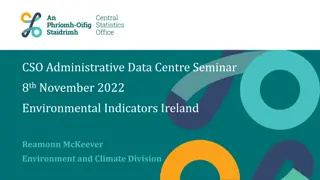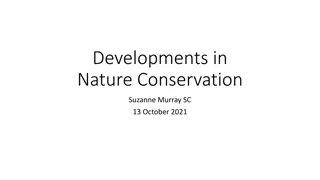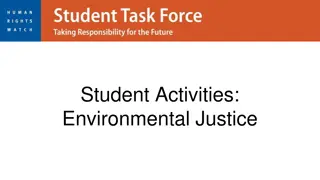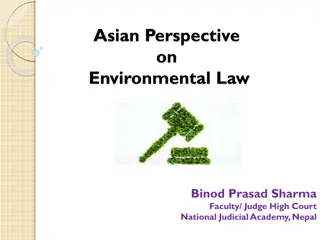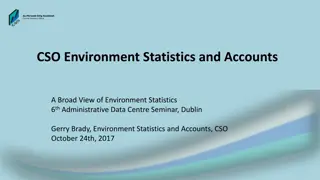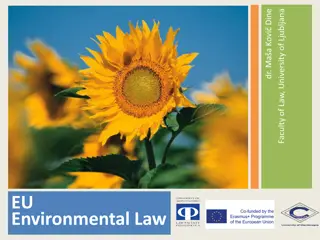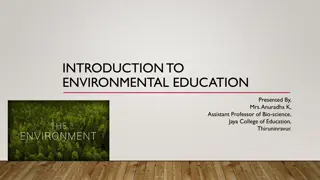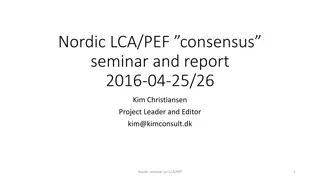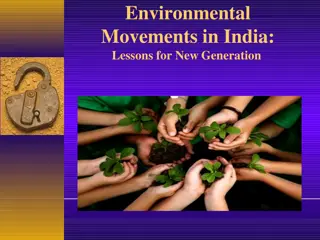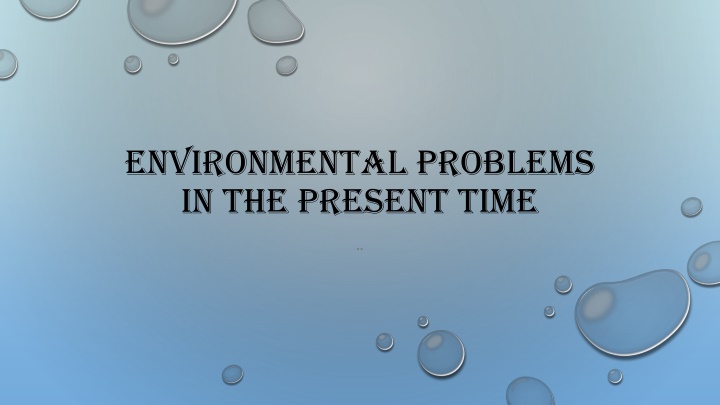
Environmental Issues Today
Environmental problems in the present time are disruptions in ecosystems caused by human impact or natural factors. These issues include climate change, pollution, resource depletion, and biodiversity loss, leading to environmental degradation. Human activities such as population growth, overconsumption, and pollution contribute to these challenges.
Download Presentation

Please find below an Image/Link to download the presentation.
The content on the website is provided AS IS for your information and personal use only. It may not be sold, licensed, or shared on other websites without obtaining consent from the author. If you encounter any issues during the download, it is possible that the publisher has removed the file from their server.
You are allowed to download the files provided on this website for personal or commercial use, subject to the condition that they are used lawfully. All files are the property of their respective owners.
The content on the website is provided AS IS for your information and personal use only. It may not be sold, licensed, or shared on other websites without obtaining consent from the author.
E N D
Presentation Transcript
ENVIRONMENTAL PROBLEMS IN THE PRESENT TIME ..
Environmental issues are disruptions in the usual function of ecosystems. Further, these issues can be caused by humans (human impact on the environment)or they can be natural. These issues are considered serious when the ecosystem cannot recover in the present situation, and catastrophic if the ecosystem is projected to certainly collapse. Environmental protection is the practice of protecting the natural environment on the individual, organizational or governmental levels, for the benefit of both the environment and humans. Environmentalism is a social and environmental movement that addresses environmental issues through advocacy, legislation education, and activism. Environment destruction caused by humans is a global, ongoing problem. Water pollution also cause problems to marine life.Most scholars think that the project peak global world population of between 9-10 billion people, could live sustainably within the earth's ecosystems if human society worked to live sustainably within planetary boundaries.The bulk of environmental impacts are caused by excessive consumption of industrial goods by the world's wealthiest populations. The UN Environmental Program, in its "Making Peace With Nature" Report in 2021, found addressing key planetary crises, like pollution, climate change and biodiversity loss, was achievable if parties work to address the
Major current environmental issues may include climate change, pollution, environmental degradation, and resource depletion. The conservation movement lobbies for protection of endangered species and protection of any ecologically valuable natural areas, genetically modified foods and global warming. The UN system has adopted international frameworks for environmental issues in three key issues, which has been encoded as the "triple planetary crises": climate change, pollution, and biodiversity loss.
Human impact on the environment (or anthropogenic environmental impact) refers to changes to biophysical environments and to ecosystems, biodiversity, and natural resources caused directly or indirectly by humans. Modifying the environment to fit the needs of society (as in the built environment) is causing severe effects including global warmingenvironmental degradation (such as ocean acidification, mass extinction and biodiversity loss, ecological crisis, and ecological collapse. Some human activities that cause damage (either directly or indirectly) to the environment on a global scale include population growth, neoliberal economic policies and rapid economic growth, overconsumption, overexploitation, pollution, and deforestation. Some of the problems, including global warming and biodiversity loss, have been proposed as representing catastrophic risks to the survival of the human species. The term anthropogenic designates an effect or object resulting from human activity. The term was first used in the technical sense by Russian geologist Alexey Pavlov, and it was first used in English by British ecologist Arthur Tansley in reference to human influences on climax plant communities. The atmospheric scientist Paul Crutzen introduced the term "Anthropocene" in the mid-1970s. The term is sometimes used in the context of pollution produced from human activity since the start of the Agricultural Revolution but also applies broadly to all major human impacts on the environment. Many of the actions taken by humans that contribute to a heated environment stem from the burning of fossil fuel from a variety of sources, such as: electricity, cars, planes, space heating, manufacturing, or the destruction of forests.
Environmental concerns can be defined as the negative effects of any human activity on the environment. The biological as well as the physical features of the environment are included. Some of the primary environmental challenges that are causing great worry are air pollution, water pollution, natural environment pollution, rubbish pollution, and so on. Environmental degradation is one of the ten threats officially cautioned by the High-level Panel on Threats, Challenges and Change of the United Nations. The United Nations International Strategy for Disaster Reduction defines environmental degradation as "the reduction of the capacity of the environment to meet social and ecological objectives, and needs". Environmental degradation comes in many types. When natural habitats are destroyed or natural resources are depleted, the environment is degraded. Efforts to counteract this problem include environmental protection and environmental resources management. Mismanagement that leads to degradation can also lead to environmental conflict where communities organize in opposition to the forces that mismanaged the environment.
The Environmental Justice Atlas documented 3,100 environmental conflicts worldwide as of April 2020 and emphasised that many more conflicts remained undocumented. Parties involved in these conflicts include locally affected communities, states, companies and investors, and social or environmental movements; typically environmental defenders are protecting their homelands from resource extraction or hazardous waste disposal. Resource extraction and hazardous waste activities often create resource scarcities (such as by overfishing or deforestation), pollute the environment, and degrade the living space for humans and nature, resulting in conflict. A particular case of environmental conflicts are forestry conflicts, or forest conflicts which "are broadly viewed as struggles of varying intensity between interest groups, over values and issues related to forest policy and the use of forest resources". In the last decades, a growing number of these have been identified globally. Frequently environmental conflicts focus on environmental justice issues, the rights of indigenous people, the rights of peasants, or threats to communities whose livelihoods are dependent on the ocean. Outcomes of local conflicts are increasingly influenced by trans-national environmental justice networks that comprise the global environmental justice movement. Environmental conflict can complicate response to natural disaster or exacerbate existing conflicts especially in the context of geopolitical disputes or where communities have been displaced to create environmental migrants. The terms socio-environmental conflict, environmental conflict, or EDCs are sometimes used interchangeably. The study of these conflicts is related to the fields of ecological economics, political ecology, and environmental justice..
The movement began in the United States in the 1980s. It was heavily influenced by the American civil rights movement and focused on environmental racism within rich countries. The movement was later expanded to consider gender, international environmental injustice, and inequalities within marginised groups. As the movement achieved some success in rich countries, environmental burdens were shifted to the Global South (as for example through extractivism or the global waste trade). The movement for environmental justice has thus become more global, with some of its aims now being articulated by the United Nations. The movement overlaps with movements for Indigenous land rights and for the human right to a healthy environment. The goal of the environmental justice movement is to achieve agency for marginalised communities in making environmental decisions that affect their lives. The global environmental justice movement arises from local environmental conflicts in which environmental defenders frequently confront multi-national corporations in resource extraction or other industries. Local outcomes of these conflicts are increasingly influenced by trans-national environmental justice networks. Environmental justice scholars have produced a large interdisciplinary body of social science literature that includes contributions to political ecology, environmental law, and theories on justice and sustainability.
The environmental movement (sometimes referred to as the ecology movement), is a social movement that aims to protect the natural world from harmful environmental practices in order to create sustainable living.[67] Environmentalists advocate the just and sustainable management of resources and stewardship of the environment through changes in public policy and individual behavior.[68] In its recognition of humanity as a participant in (not an enemy of) ecosystems, the movement is centered on ecology, health, as well as human rights. The environmental movement is an international movement, represented by a range of environmental organizations, from enterprises to grassroots and varies from country to country. Due to its large membership, varying and strong beliefs, and occasionally speculative nature, the environmental movement is not always united in its goals. At its broadest, the movement includes private citizens, professionals, religious devotees, politicians, scientists, nonprofit organizations, and individual advocates like former Wisconsin Senator Gaylord Nelson and Rachel Carson in the 20th century.


